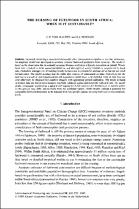JavaScript is disabled for your browser. Some features of this site may not work without it.
- ResearchSpace
- →
- Research Publications/Outputs
- →
- Journal Articles
- →
- View Item
| dc.contributor.author |
Von Maltitz, Graham P

|
en_US |
| dc.contributor.author |
Scholes, RJ

|
en_US |
| dc.date.accessioned | 2007-03-14T13:35:47Z | en_US |
| dc.date.accessioned | 2007-06-07T10:09:54Z | |
| dc.date.available | 2007-03-14T13:35:47Z | en_US |
| dc.date.available | 2007-06-07T10:09:54Z | |
| dc.date.copyright | en_US | |
| dc.date.issued | 1995-11 | en_US |
| dc.identifier.citation | Von Maltitz, GP and Scholes, RJ. 1995. Burning of fuelwood in South Africa: when is it sustainable?. Environmental Monitoring and Assessment, vol. 38, 03 February, pp 243-251 | en_US |
| dc.identifier.issn | 0167-6369 | en_US |
| dc.identifier.uri | http://hdl.handle.net/10204/1942 | en_US |
| dc.identifier.uri | http://hdl.handle.net/10204/1942 | |
| dc.description.abstract | Fuel wood harvesting is considered sustainable when consumption is equal to or less than production. An empirical model was developed to estimate potential fuel wood production from savannas. The model is based on the observation that in semiarid savannas, biomass production is linearly dependent on rainfall. Woody basal area is linked to mean annual precipitation, and aboveground woody biomass is proportional to basal area. Production averages 4% of standing woody biomass and is corrected to exclude stems that are too small for harvesting. The model assumes that the entire area consists of semi natural savanna. Corrections for the land lost as a result of land transformation and degradation would have to be included. Data on land loss can most effectively be obtained from satellite imagery, with appropriate ground calibration. The model is based on limited data sets but in most instances has been validated against independently collected data. The model yields a reasonable prediction at a national and regional level, but estimates for limited areas or specific points on the ground may differ substantially from the predicted values. Model results indicate a potential for sustainable fuel wood production at the national level, but specific regions are using fuel wood at nonsustainable level. | en_US |
| dc.format.extent | 534723 bytes | en_US |
| dc.format.mimetype | application/pdf | en_US |
| dc.language.iso | en | en_US |
| dc.publisher | Kluwer Academic Publishers | en_US |
| dc.rights | Copyright: 1995 Kluwer Academic Publishers | en_US |
| dc.source | en_US | |
| dc.subject | Fuel wood | en_US |
| dc.subject | South Africa | en_US |
| dc.subject | Burning | en_US |
| dc.title | Burning of fuelwood in South Africa: when is it sustainable? | en_US |
| dc.type | Article | en_US |
| dc.identifier.apacitation | Von Maltitz, G. P., & Scholes, R. (1995). Burning of fuelwood in South Africa: when is it sustainable?. http://hdl.handle.net/10204/1942 | en_ZA |
| dc.identifier.chicagocitation | Von Maltitz, Graham P, and RJ Scholes "Burning of fuelwood in South Africa: when is it sustainable?." (1995) http://hdl.handle.net/10204/1942 | en_ZA |
| dc.identifier.vancouvercitation | Von Maltitz GP, Scholes R. Burning of fuelwood in South Africa: when is it sustainable?. 1995; http://hdl.handle.net/10204/1942. | en_ZA |
| dc.identifier.ris | TY - Article AU - Von Maltitz, Graham P AU - Scholes, RJ AB - Fuel wood harvesting is considered sustainable when consumption is equal to or less than production. An empirical model was developed to estimate potential fuel wood production from savannas. The model is based on the observation that in semiarid savannas, biomass production is linearly dependent on rainfall. Woody basal area is linked to mean annual precipitation, and aboveground woody biomass is proportional to basal area. Production averages 4% of standing woody biomass and is corrected to exclude stems that are too small for harvesting. The model assumes that the entire area consists of semi natural savanna. Corrections for the land lost as a result of land transformation and degradation would have to be included. Data on land loss can most effectively be obtained from satellite imagery, with appropriate ground calibration. The model is based on limited data sets but in most instances has been validated against independently collected data. The model yields a reasonable prediction at a national and regional level, but estimates for limited areas or specific points on the ground may differ substantially from the predicted values. Model results indicate a potential for sustainable fuel wood production at the national level, but specific regions are using fuel wood at nonsustainable level. DA - 1995-11 DB - ResearchSpace DP - CSIR KW - Fuel wood KW - South Africa KW - Burning LK - https://researchspace.csir.co.za PY - 1995 SM - 0167-6369 T1 - Burning of fuelwood in South Africa: when is it sustainable? TI - Burning of fuelwood in South Africa: when is it sustainable? UR - http://hdl.handle.net/10204/1942 ER - | en_ZA |






